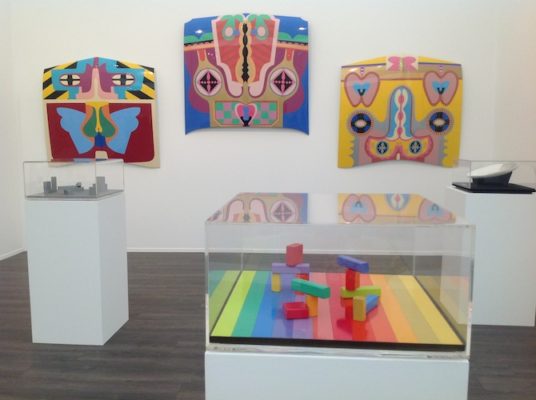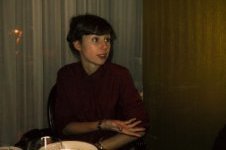Search
To search for an exact match, type the word or phrase you want in quotation marks.
A*DESK has been offering since 2002 contents about criticism and contemporary art. A*DESK has become consolidated thanks to all those who have believed in the project, all those who have followed us, debating, participating and collaborating. Many people have collaborated with A*DESK, and continue to do so. Their efforts, knowledge and belief in the project are what make it grow internationally. At A*DESK we have also generated work for over one hundred professionals in culture, from small collaborations with reviews and classes, to more prolonged and intense collaborations.
At A*DESK we believe in the need for free and universal access to culture and knowledge. We want to carry on being independent, remaining open to more ideas and opinions. If you believe in A*DESK, we need your backing to be able to continue. You can now participate in the project by supporting it. You can choose how much you want to contribute to the project.
You can decide how much you want to bring to the project.

London never fails to surprise me. Its districts change, reinvent themselves and die, all at breakneck speed. In 2011 the East of the city, until then solely connected with the centre by sordid buses, opened up a tube line from north to south connecting it directly with the City. Immediately afterwards suited executives began to appear like mushrooms, setting up bicycle shops in these Jamaican neighbourhoods. In the decadent building where I lived in 2006, where at night I took the precaution of arriving accompanied, they have opened a large vintage shop on the ground floor and the corner pub, the one with the rank smell of beer, now forms part of a well known chain of “gastro pubs”. The same old story, this time seen from a distance, and why not, with a touch of nostalgia. .
London is a fantastic place to observe neoliberalism in all its glory. There, the confusion between past and present, the new and the old, is transformed into the best merchandise, with the alternative becoming mainstream at a voracious speed. The art world becomes an excellent example with which to portray the situation, acquiring its maximum splendour during the month of October thanks to Frieze, the London Film Festival and many other events that saturate a city that is already rich in cultural offerings. Like all good companies created with the support of financial capital, Frieze, that began in 1991 as a magazine, has become a veritable corporation that encompasses a second magazine Frieze d/e, published bilingually in German/English; two fairs, one in London and another in New York; and Frieze Foundation, a foundation that during the days of the fair produces art projects, an interesting programme of talks, as well as film and music sessions.
Like all good companies created with the support of financial capital, Frieze, that began in 1991 as a magazine, has become a veritable corporation that encompasses a second magazine Frieze d/e, published bilingually in German/English; two fairs, one in London and another in New York; and Frieze Foundation, a foundation that during the days of the fair produces art projects, an interesting programme of talks, as well as film and music sessions.
The stands of the fair have become the least interesting, a stroll through a supermarket of art, of more or less consolidated figures, whose installations and videos become collages and Polaroids. Despite all this tickets to the fair are still sold out every day, just like those for the main exhibitions at the Tate Modern or for a rock concert to the Shepherds Bush Empire. Thanks to Saatchi and the world of finance, in London contemporary art is pop. The large galleries like Lisson or Hauser & Wirth have increasingly larger spaces and more branches in emerging countries and the Serpentine Gallery is inaugurating a new building in Hyde Park itself, with an extension realised by the stellar architect Zaha Hadid.
And when the contemporary art market –like that of any luxury product- becomes mainstream it has to reinvent itself to regain the status of exclusivity. This is how, having sold out at the box-office, Frieze becomes a museum. 2013 is the second year of the acclaimed Frieze Masters, a second fair ten minutes walk from the main Frieze pavilion, which brings together “the great masters with a contemporary gaze”. Spotlight is a section curated by Adriano Pedrosa that brings together a collection of galleries that present stands dedicated to just one historic artist, endeavouring to escape the classics of the Western conceptual-minimalist pantheon. While curators and artists revel in the museum quality of the pieces, the sacrosanct history of art doesn’t hide its condition as merchandise. Aside from its snob value, Frieze Masters triumphs because it deploys an infinity of references, masters and fetishes for all tastes. The art of Pacific tribes coexists alongside works by the feminist pioneer Judy Chicago, Rembrandts, photographs by the African Malick Sibidé, Gerhard Richters and photograms by Man Ray. All excellently displayed, clutter free, and with no need to go round the world to see them. A fantastic case study of the new pathways of cultural logic in late capitalism.

Rosa Lleó has been a publisher. From her years in England she has kept the short sentences and vinyl records. Now she writes and occasionally makes exhibitions.
"A desk is a dangerous place from which to watch the world" (John Le Carré)